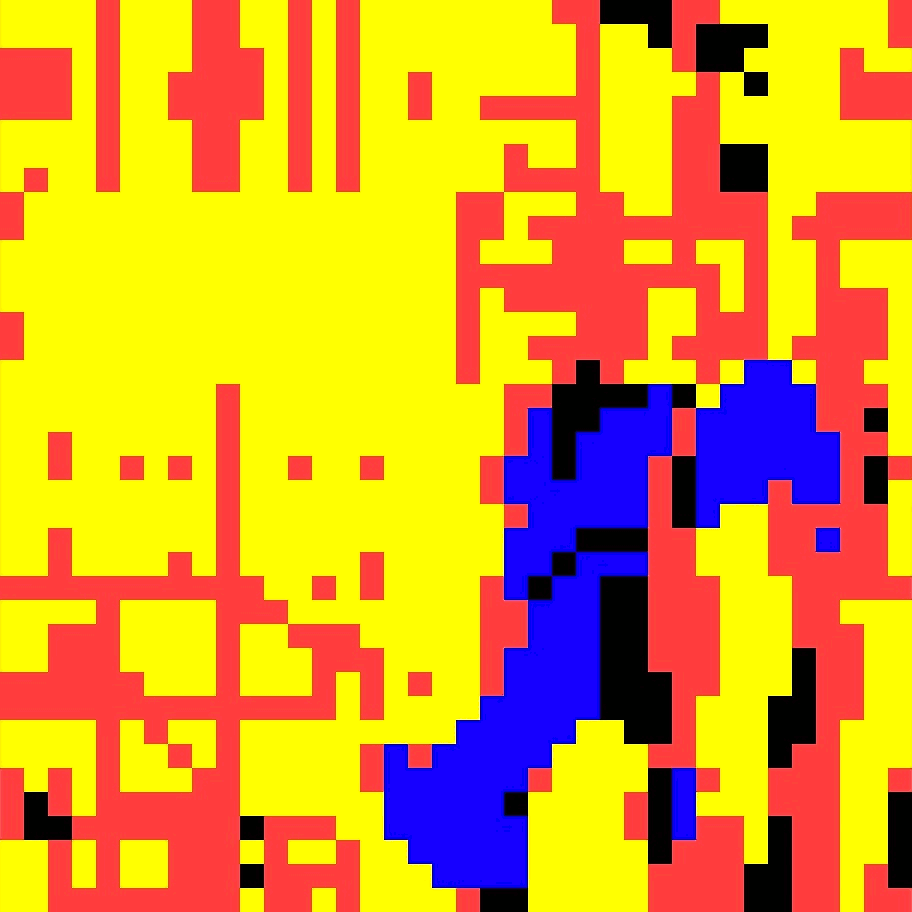K. Andrew Watson.
ML Engineer & Designer
(ende)Coded
Dimensionality reduced images rendered into color abstraction.
Can the image be reconstructed?
Does the image have a fundamental unit of self-reference AND Identity in all resolutions? It would seem at some reduced resolution n x n the image becomes ambigious however by mapping these atomic elements and performing some calculation it is possible in most cases to faithfully reconstuct (decode) the image faithfully even from samples which have a very low resolution. How can images in a different dimensionality or resolution be combined in novel ways? Are the the relationships between atomic, decoded elements extensive to dimensions beyond a simple a -> a mapping? Is there a coded map of meta-dimensional relationships in this manner? Are these maps ambigious? Are the calculable? What is the relationship between the set of all maps and the set of all constructable art pieces? In what dimensionality would this be discreetly expressed in? If two images are auto encoded and/or dimensionally reduced what is the relationship between the reduced and non-reduced elements? Is there a shared form or abstraction which all others might be reduced to and extended from? Is this line of thought productive? If we found a unique form, object, or idea which had some property by which it could not be reduced or extended to in this manner- what would it look like? What would it sound like?
Is silence self-referencially non reducable?
Can some (potential infinite) span of silence be meaningfully segmented? If not then isn't it necessarily the case that discreet sound as such is an illusion? A, "distortion" of irreducible silence? Perhaps just the opposite is true-- Perhaps there is only some sort of primordial sound and all lapses in this sound (perceived as silence) are a temporal illusion in consciousness?
Is color a perversion of white light?
Is there a Universal Art Function Approximator? If not, why?
Personal Conclusion so far unproven-- Without the existence of some infinte substance(s) (probably relating to the human soul or the basal element of Consciousness which has so far eluded contemporary science) art and art pieces would not be possible. Art may very well be the result of combining some inert element(s) or unit(s) of consciousness (which may or may not exist independently) with some infinite, infinitely boundless gradial substance which gives rise to the artistic experience. It's worth noting that in some system of ontology we may employ we may say that the initial objects cannot exist independently of their conscious observance-- What this means is that the artistic elements and aesthetic enterprises are in this system an inate function and part of the total anatomy of the , "consciousness" involved with the thing at hand. Art might not be some function of nature as it is commonly thought-- An emergent complexity and beauty emerging out of thermodynamic upturns-- No but rather an artifact or a, "pointer" to some reality which exists outside of the bounds of the obvious bounds of the one we are most commonly presented with in day to day life. This means that art is a spiritual enterprise by nature meaning understanding, creating, and participating in artful enterprise is necessary for the human condition the same way breathing, making love, or taking food are. It's just by some curious token that the actual value of this can't be surmised in material designations so plainly-- This is because the capital by which we buy, sell, and exchange artistic value is distributed in Heaven only; in the boundless reality from which we all stem and of which we all secretely and not-so secretly aspire. This is my basic conclusion I have drawn from these works and experiments. Thank you. --K.A. Watson.
Is your red the same as my red? Who cares. Let's just have some fun. Let's make good on this empty canvas of consciousness that's been given to us. Let's use our inner joy and loving sentiment as a guide. We'll use our hearts and feelings as our compass- We'll create to the measure that's been alloted by our environment. We'll act as servants to some unfathomable higher good inate and intimately bound that most universal of things of which is our pursuit. In all this discussion let's not forget that-- That universal thing we all call, "beautiful" "spotless" and "without fault." God willing we may find ourselves in a realm where the measure is not, "without fault" but the contrary, positive!-- perhaps some day we will find ourselves in a realm where things en mass are not saying, "No, not this! Not that!" bur rather, "Yes! Om! Yes! Quite like that! I love you for this!" Until then we can dream.
References- Kandinsky- On Spirituality in Art, Vyasa- Srimad Bhagavatam Purana.
Hare Krishna.
 IMG_20180926_213909_926 |  IMG_20180926_224725_674 |
|---|---|
 IMG_20180926_224708_312 |  IMG_20180926_224338_764 |
 IMG_20180926_215801_613 |  IMG_20180926_215743_847 |
 letsfuck |  IMG_20180926_215724_568 |
 IMG_20180926_215615_852 |